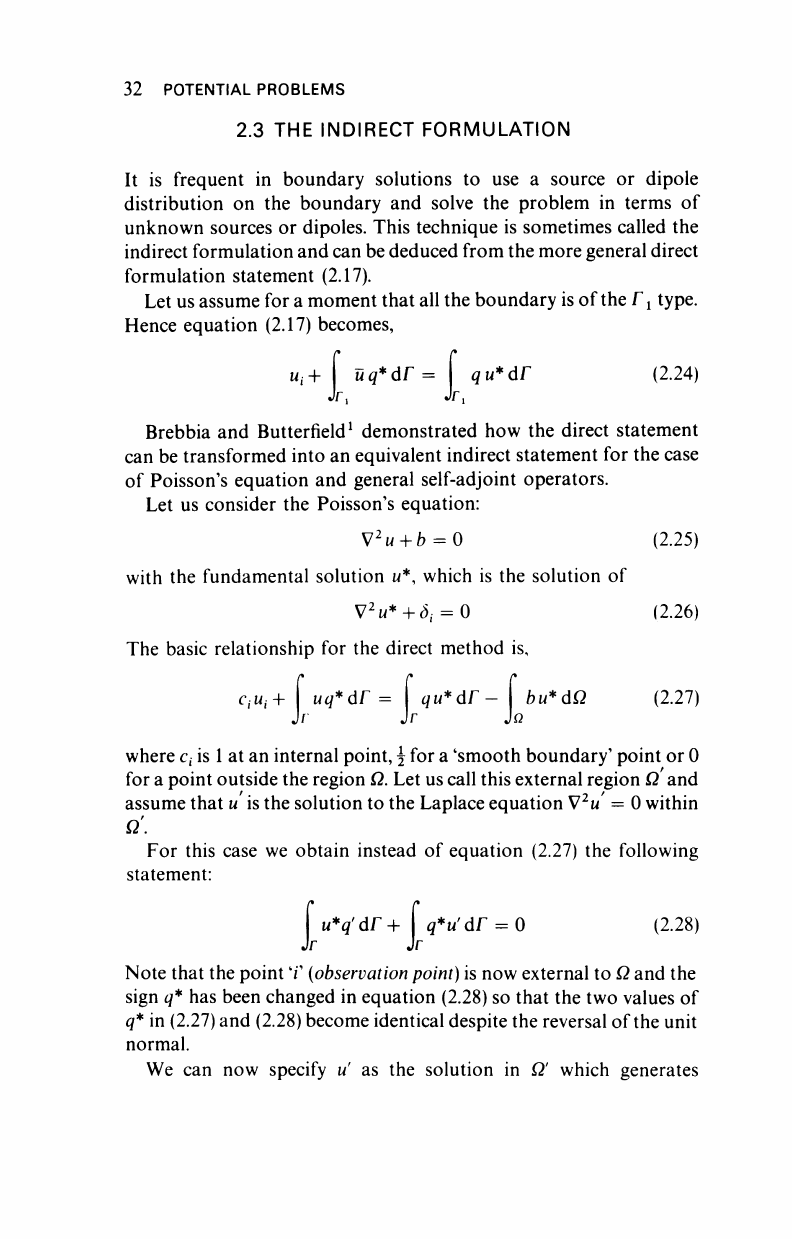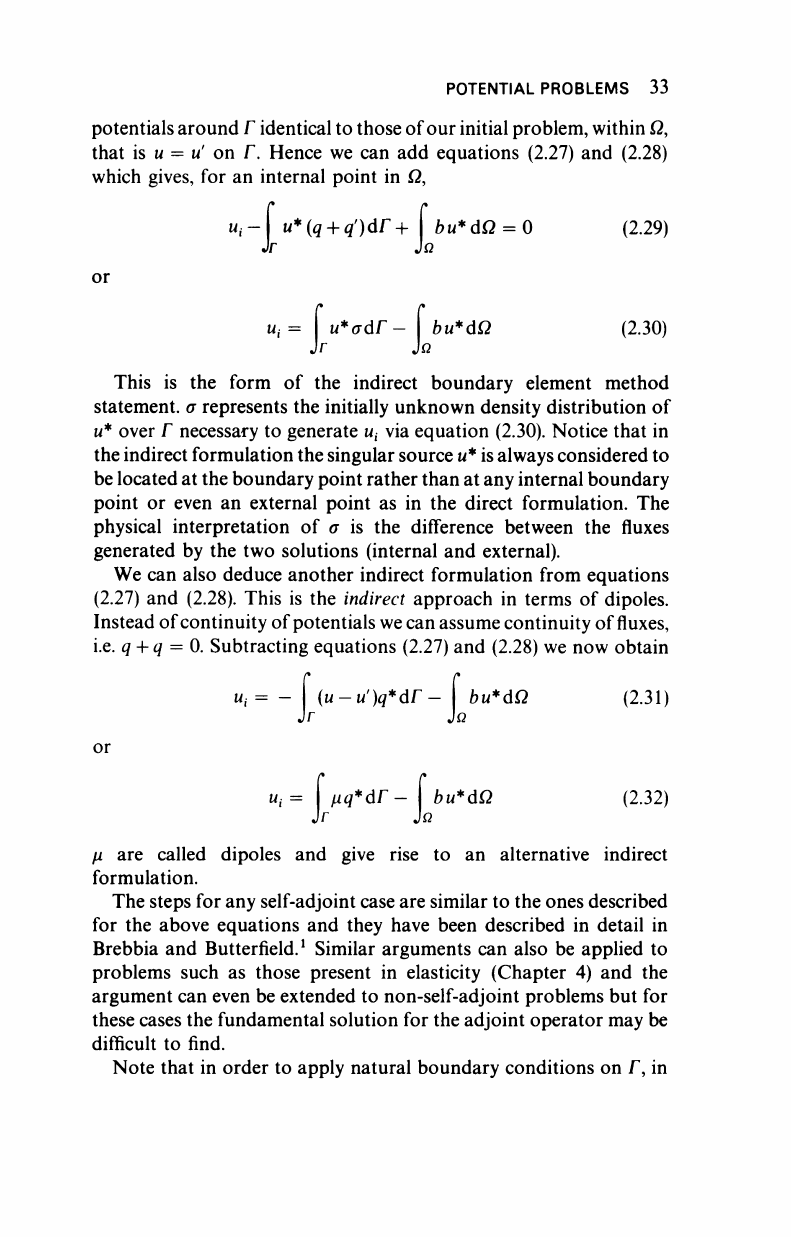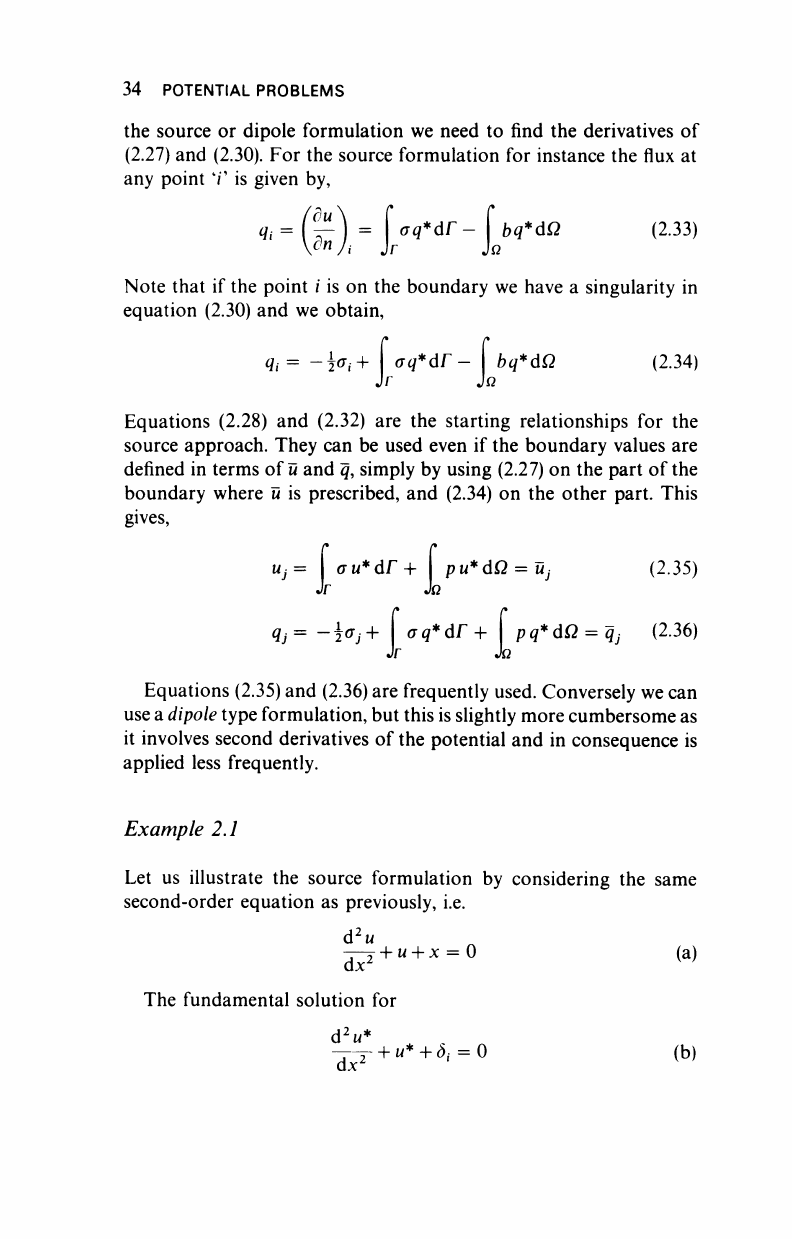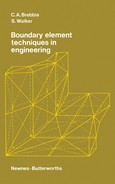
32 POTENTIAL PROBLEMS
2.3 THE INDIRECT FORMULATION
It is frequent in boundary solutions to use a source or dipole
distribution on the boundary and solve the problem in terms of
unknown sources or dipoles. This technique is sometimes called the
indirect formulation and can be deduced from the more general direct
formulation statement (2.17).
Let us assume for a moment that all the boundary is of the Γ
ι
type.
Hence equation (2.17) becomes,
«i
+
uq*di =
q
u*
άΓ (2.24)
Brebbia and Butterfield
1
demonstrated how the direct statement
can be transformed into an equivalent indirect statement for the case
of Poisson's equation and general self-adjoint operators.
Let us consider the Poisson's equation:
V
2
u + b = 0 (2.25)
with the fundamental solution u*, which is the solution of
V
2
i/*+<$,· = () (2.26)
The basic relationship for the direct method is,
c
i
u
i + uq*dr =
Jr
J
qu*dr
r
bu*dQ (2.27)
Ω
where c, is
1
at an internal point, for a 'smooth boundary' point or 0
for a point outside the region
Ω.
Let us call this external region Ω and
assume that u is the solution to the Laplace equation V
2
t/ = 0 within
Ω'.
For this case we obtain instead of equation (2.27) the following
statement:
I
u*q'dr +
q*u'dr = 0 (2.28)
Note that the point T (observation point) is now external to Ω and the
sign q* has been changed in equation (2.28) so that the two values of
q* in (2.27) and (2.28) become identical despite the reversal of the unit
normal.
We can now specify u' as the solution in Ω' which generates

POTENTIAL PROBLEMS 33
potentials around Γ identical to those of our initial problem, within Ω,
that is u = u' on Γ. Hence we can add equations (2.27) and (2.28)
which gives, for an internal point in Ω,
".- u*(q + qf)dr + bu*dQ = 0 (2.29)
or
Ui=
u*adr-
bu*dQ (2.30)
This is the form of the indirect boundary element method
statement, σ represents the initially unknown density distribution of
u* over Γ necessary to generate w, via equation (2.30). Notice that in
the indirect formulation the singular source
u*
is always considered to
be located at the boundary point rather than at any internal boundary
point or even an external point as in the direct formulation. The
physical interpretation of σ is the difference between the fluxes
generated by the two solutions (internal and external).
We can also deduce another indirect formulation from equations
(2.27) and (2.28). This is the indirect approach in terms of dipoles.
Instead of continuity of potentials we can assume continuity of fluxes,
i.e. q + q = 0. Subtracting equations (2.27) and (2.28) we now obtain
U,;= ~ (U
■
u')q*df
—
bu*dQ (2.31)
Ω
or
U: =
ßq*df-
bu*dQ (2.32)
μ are called dipoles and give rise to an alternative indirect
formulation.
The steps for any self-adjoint case are similar to the ones described
for the above equations and they have been described in detail in
Brebbia and Butterfield.
1
Similar arguments can also be applied to
problems such as those present in elasticity (Chapter 4) and the
argument can even be extended to non-self-adjoint problems but for
these cases the fundamental solution for the adjoint operator may be
difficult to find.
Note that in order to apply natural boundary conditions on Γ, in

34 POTENTIAL PROBLEMS
the source or dipole formulation we need to find the derivatives of
(2.27) and (2.30). For the source formulation for instance the flux at
any point '/" is given by,
«-(?£),-i^-i*
4
**
0
(133)
Note that if the point i is on the boundary we have a singularity in
equation (2.30) and we obtain,
q
x
= -ifff-f
aq*dr
bq*dQ (2.34)
Equations (2.28) and (2.32) are the starting relationships for the
source approach. They can be used even if the boundary values are
defined in terms of« and q, simply by using (2.27) on the part of the
boundary where ü is prescribed, and (2.34) on the other part. This
gives,
au*dr +
lj= -K+
σ
p
u* άΩ = Uj
Jfi
q*dr +
pq*dQ = qj
Ω
(2.35)
(2.36)
Equations (2.35) and (2.36) are frequently used. Conversely we can
use a dipole type formulation, but this is slightly more cumbersome as
it involves second derivatives of the potential and in consequence is
applied less frequently.
Example 2.1
Let us illustrate the source formulation by considering the same
second-order equation as previously, i.e.
d^w
dx
:
-
+ u
+ x = 0
The fundamental solution for
d
2
u*
dx
2
+
U*
+
δ:
= 0
(a)
(b)
..................Content has been hidden....................
You can't read the all page of ebook, please click here login for view all page.
